#beaver territory
Explore tagged Tumblr posts
Photo

#photographers on tumblr#original photographers#landscape#nature#floodplain forest#trees#willows#pond#vltava#modřany and komořany pools national monument#přírodní památka modřanské a komořanské tůně#modřany#modřanské laguny#beaver territory
2 notes
·
View notes
Text
composition #9

1 note
·
View note
Text
i will say im a windclan moor >>> windclan prairie truther in my heart but i also think looking at "warrior cats is set in the new forest/england/the uk" and going "no it's not. it's actually set wherever i live" is awesome so whatever. whatever you think is right and whatever i think is right. 10 billion creative and inspired by personal experience warrior cats settings forever
#USamerican fans you guys may be oversaturating the headcanon department due to how many of you there are#but it's not like the series' setting is concrete anyways and also fuck england#if the series was set somewhere in the usa the wildlife would be way more diverse and interesting at least#and who is anyone to rob someone of going to some sort of open field or plain or hill near them and going wow...... windclan territory#that being said heather and gorse is pretty#also to be clear this isnt meant to be dismissive of anyones opinions on this rather just accepting of Them All#if youre very passionate about the sanctity of english warrior cats then i also respect that#i just think arguments about beavers/mountain lions or whatever is silly when everyone is bringing their own vision
95 notes
·
View notes
Text

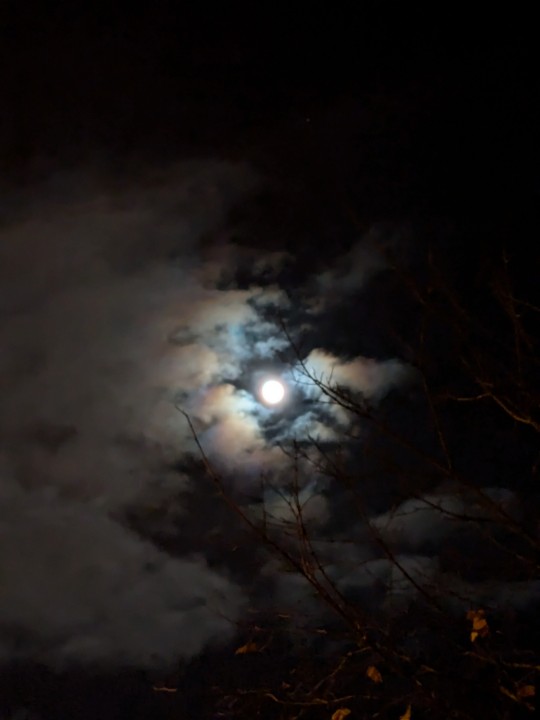
She never looks as good on my camera as she does in person.
8 notes
·
View notes
Text










Yellowknife, NWT (No. 4)
The Wildcat Café is the most famous restaurant in town and a favourite for visitors during the summer. It was opened in 1937 by Willy Wiley and Smokey Stout. The small addition at the front door was built in 1939 and was used as an ice cream parlour. The café closed in 1951 and was due for demolition until a group of local citizens formed the Old Stope Association to preserve the building. In 1979, the Wildcat Café was reopened as a summer restaurant and continues to operate under the protection of the City of Yellowknife. The building is a designated heritage site and celebrated with a replica in Canada’s Museum of Civilization in Ottawa, Ontario.
The summer of 1946 was a busy time for air traffic in Yellowknife as the hunt for gold was on. This building was a modern facility when finished by its first owners, Canadian Pacific Airlines, who held a virtual monopoly on air flights in the north during and immediately after the war. It had an office, dispatch, warehouse, passenger waiting room, and staff accommodations upstairs. In the early days it was the scene of many parties and banquets. Subsequent owners included Associated Airways, Pacific Western Airlines, Northward Aviation, Air Dogrib, and Adventure Air. In the 1990s it operated as a micro-brewery and part of the décor was a wing of a Beaver airplane which was the bar counter. It was designated a heritage site in 1992.
Source
#Summer Flies by Vicki Tompkins & Dot Van Vliet#Canadian Pacific Air Building#Yellowknife#NWT#Northwest Territories#Old Town Yellowknife#nature#travel#original photography#vacation#tourist attraction#landmark#landscape#Canada#summer 2024#cityscape#architecture#log cabin#the North#tree#flora#Great Slave Lake#marina#Wildcat Café#de Havilland Canada DHC-2 Beaver#Dhalia Shari
3 notes
·
View notes
Text
There are only six people, including me, dressed up for Halloween. There are AT LEAST 150 people in the building.
What is the Halloween equivalent of a Scrooge? 😂 Come on all, even just some orange and black will get you in the spirit!!
#though i am in U of O Duck territory#so maybe they don’t want people thinking they are Beaver fans lmao#ella speaks
0 notes
Text
This is a really exciting development! We've already seen the positive effects of beavers returning to their historic range here in North America, so it's even better to see the same thing underway across the Atlantic. A single pair with their first litter of kits certainly isn't a large-scale reintroduction, but it's proof that these animals have the capacity to get back to work here.
Beavers are often called ecosystem engineers, and for good reason. These keystone species alter waterways by building dams and lodges, creating ponds and other aquatic habitats for species that can't handle faster-moving water. These also often serve as water reservoirs during summer droughts. The dams and lodges themselves may also provide nesting sites for birds and shelter for other animals, plants, and fungi.
Sadly there are still people who want to see beavers trapped and hunted as pests because their dams can sometimes flood fields, to include those that were historically seasonal wetlands. Until we stop seeing animals' value only in terms of whether they're useful to us or not, the beavers are going to face opposition as they reclaim their old territories on both continents.
Nonetheless, I give a hearty cheer to the Mammalian Corps of Engineers!
#beavers#beaver#mammals#rodent#wildlife#animals#ecosystems#ecology#restoration ecology#nature#environment#conservation#science#scicomm#hopepunk#endangered species#extinction#biodiversity#wild animals#good news
993 notes
·
View notes
Text
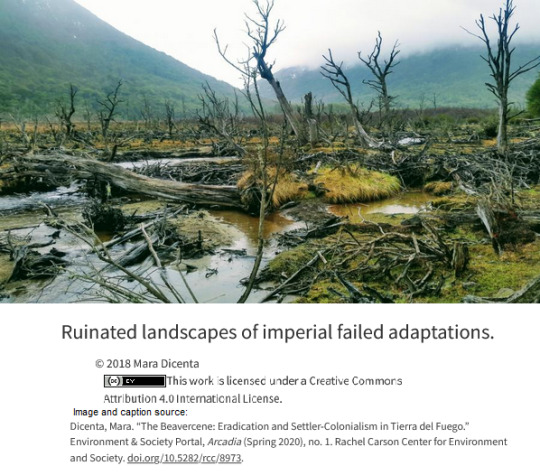
In 1946, Argentina introduced twenty beavers (Castor canadensis) to Tierra del Fuego (TdF) to promote the fur industry in a land deemed empty and sterile.
Beavers were brought from Canada by Tom Lamb, [...] known as Mr. North for having expanded the national frontier [...]. In the 1980s, local scientists [...] found that beavers were the main disturbers of sub-Antarctic forests. The fur industry had never been implemented in TdF and [...] beavers had expanded, crossed to Chile, and occupied most of the river streams. The Beavercene resulted in apocalyptic landscapes [...]: modified rivers, flooded lands, and dead native trees that, unlike the Canadian ones, are not resilient to flooding. [...]
At the end of the nineteenth century the state donated lands to Europeans who, in building their farms, also displaced and assassinated the indigenous inhabitants of TdF. With the settlers, livestock and plants also invaded the region, an “ecological imperialism” that displaced native populations. In doing this, eugenic and racializing knowledges mediated the human and nonhuman population politics of TdF.
---
In the 1940s, the Argentinian State nationalized these settlers’ capitals by redistributing their lands. [...] In 1946, the president of the rural association in TdF opened the yearly livestock [conference]: We, settlers and farmers of TdF have lived the evolution of this territory from the times of an absent State. [...] [T]hey allied with their introduced animals, like the Patagonian sheep or the Fuegian beaver. At a time when, after the two world wars, the category of race had become [somewhat] scientifically delegitimized, the enhancement and industrialization of animals enabled the continuation of racializing politics.
In 1946, during the same livestock ceremony in TdF, the military government claimed:
This ceremony represents the patria; it spreads the purification of our races … It is our desire to produce an even more purified and refined race to, directly, achieve the aggrandizement of Argentina.
---
The increasing entanglement between animal breeding and the nation helped to continue the underlying Darwinist logic embedded in population politics. Previous explicit desires to whiten the Argentinian race started to be actualized in other terms. [...]
Settlers had not only legitimated their belonging to TdF by othering the indigenous [people], [...] but also through the idea that indigenous communities had gone extinct after genocide and disease. At that time, the “myth of extinction” helped in the construction of a uniform nation based on erasing difference, as a geography textbook for school students, Historia y Geografía Argentinas, explained in 1952: If in 1852 there were 900,000 inhabitants divided in 90,000 whites, 585,000 mestizos, 90,000 [Indigenous people] and 135,000 [...] Black, a century later there was a 90% of white population out of 18,000,000 inhabitants. (357) [...] [S]tate statistics contributed to the erasure of non-white peoples through the magic of numbers: it is not that they had disappeared, but that they had been statistically exceeded [...]. However, repressed communities never fully disappear.
---
Text by: Mara Dicenta. "The Beavercene: Eradication and Settler-Colonialism in Tierra del Fuego". Environment & Society Portal, Arcadia (Spring 2020), no. 1. Rachel Carson Center for Environment and Society. [Image by Mara Dicenta, included in original article. Bold emphasis and some paragraph breaks/contractions added by me.]
#ecology#imperial#colonial#abolition#landscape#caribbean#indigenous#multispecies#temporality#haunted#tidalectics
407 notes
·
View notes
Note
This may have been thought of at some point but the specific idea of Arceus having similar instincts as a beaver when it compulsively fixes holes in the fabric of space time to guarantee it’s has a safe territory *and* it having enough pattern awareness and understanding to know that humans=helpful that many real life animals are able to recognize (for example elephants seeking out rangers for health care) rather than it being a weird god horse is so much more compelling to me personally.
OOOHHH I LIKE YOUR THINKING I LOVE THIS LOVE LOVE LOVE
It's like it's this fourth dimensional being that ultimately does not communicate nor think the same way a human does... But it does know how to problem solve.
43 notes
·
View notes
Photo

#photographers on tumblr#original photographers#black and white#landscape#nature#water reflection#floodplain forest#beaver territory#willows#přírodní památka modřanské a komořanské tůně#modřany and komořany pools national monument#vltava#modřany#bnw#b&w
4 notes
·
View notes
Text

midwinter respite
0 notes
Text
The Prospects by KT Hoffman

The pressure cooker of minor league baseball leads to major chemistry in this exhilarating, sexy, and triumphant rivals to lovers debut romance.
Hope is familiar territory for Gene Ionescu. He has always loved baseball, a sport made for underdogs and optimists like him. He also loves his team, the minor league Beaverton Beavers, and, for the most part, he loves the career he’s built. As the first openly trans player in professional baseball, Gene has nearly everything he’s ever let himself dream of—that is, until Luis Estrada, Gene’s former teammate and current rival, gets traded to the Beavers, destroying the careful equilibrium of Gene’s life.
Gene and Luis can’t manage a civil conversation off the field or a competent play on it, but in the close confines of dugout benches and roadie buses, they begrudgingly rediscover a comfortable rhythm. As the two grow closer, the tension between them turns electric, and their chemistry spills past the confines of the stadium. For every tight double play they execute, there’s also a glance at summer-tan shoulders or a secret shared, each one a breathless moment of possibility that ignites in Gene the visceral, terrifying kind of desire he’s never allowed himself. Soon, Gene has to reconcile the quiet, minor-league-sized life he used to find fulfilling with the major-league dreams Luis makes feel possible.
A joyful, heartfelt debut rom-com revealing what’s possible when we allow ourselves to want something enough to swing for the fences.
51 notes
·
View notes
Text


The moon is my guide and teacher.
She cycles through stages of full and rest, but never gives up her cycles. She tries again and is always beautiful in every stage. When she rests we see the stars more fully and appreciate her when we see her crescent waxing again to bring us light.
Her brightness can be too bright sometimes, when we wish to be in the dark. But we love her and know she is giving us love, and we can wait for the dark to see the stars and reflect again when we need.
She inspires us always, even when she is not full. She sways our tides to help give us current, feeds life on earth with her ever reliable rhythms. We know what to expect and can work with her to feed off her energy and become full ourselves.
The moon is my goddess and guide. I love her and am grateful for her.
#2024#coast salish territory#moon#waning gibbous#beaver moon#november#day moon#sky#wispy clouds#gratitude#my words#cloverquest.txt
3 notes
·
View notes
Text

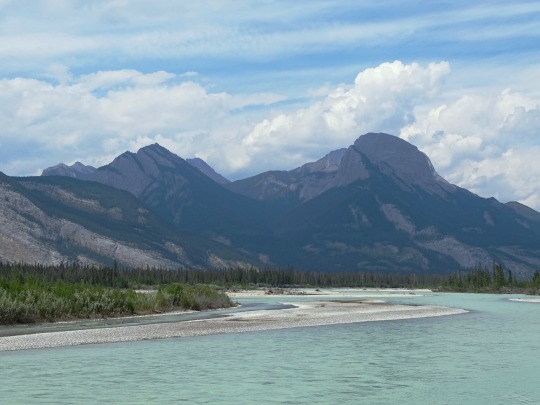
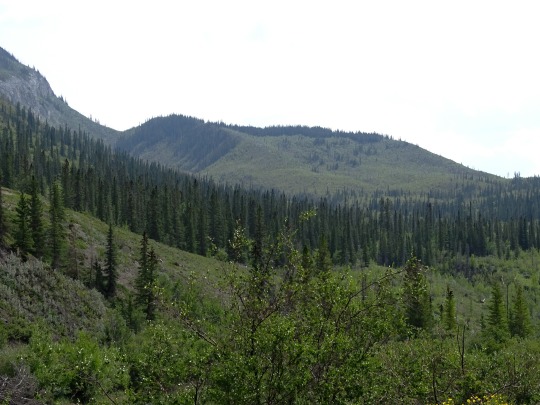
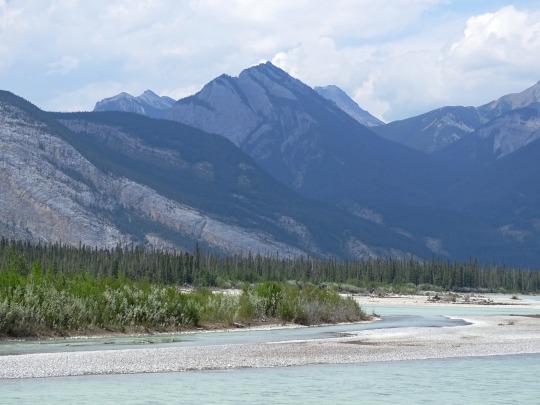
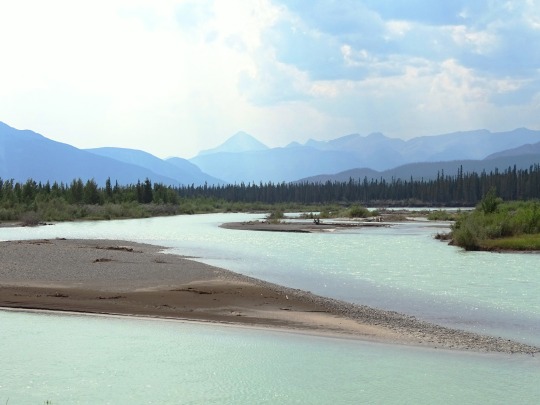
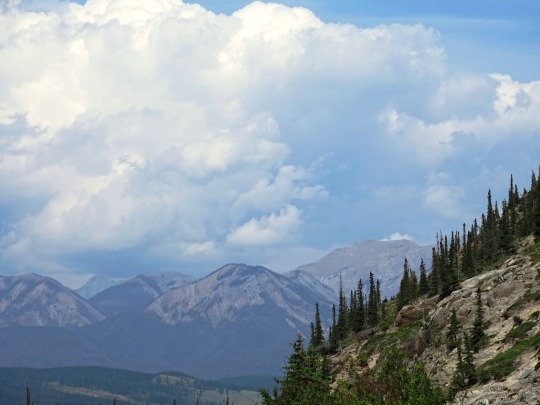
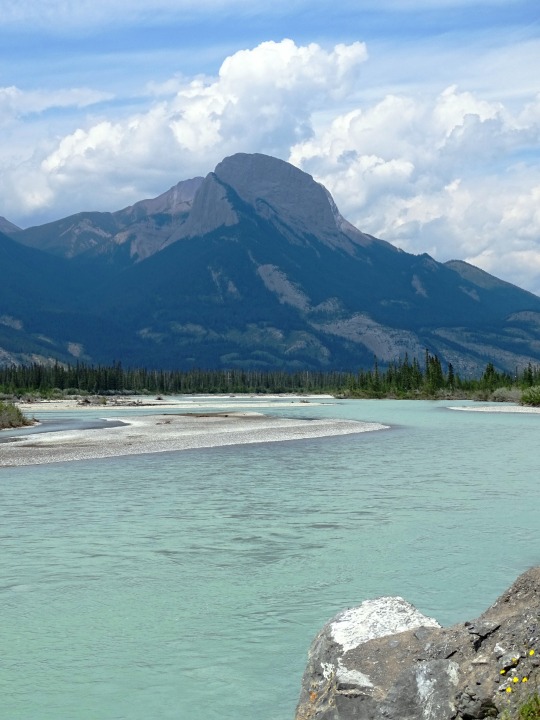
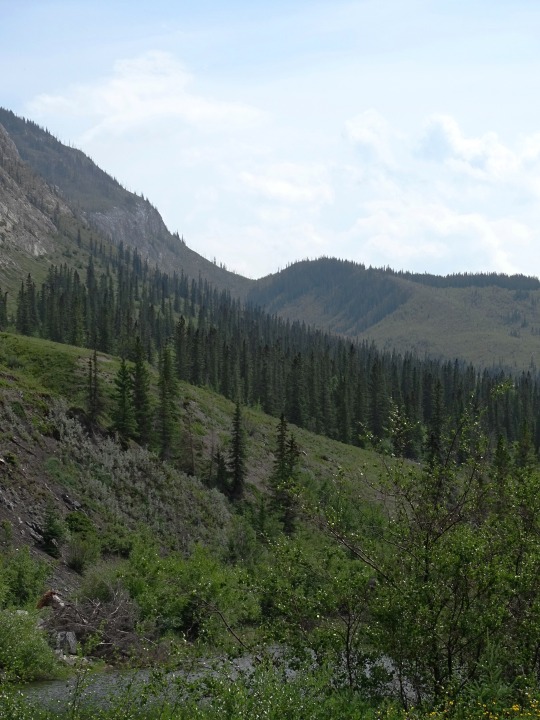
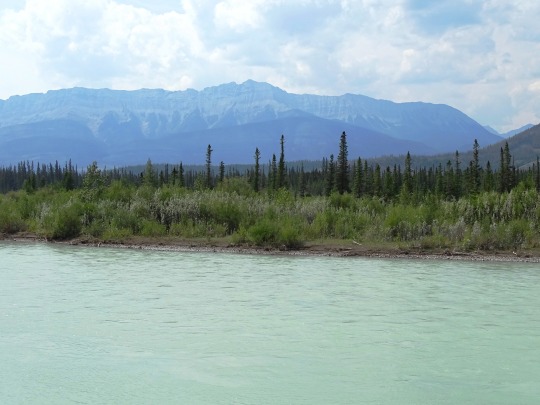
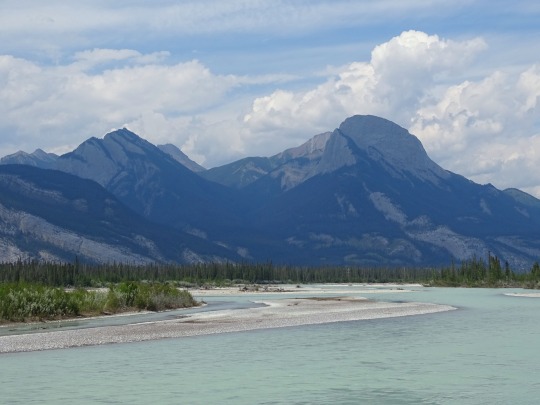
Jasper National Park, AB (No. 1)
Jasper National Park, in Alberta, Canada, is the largest national park within Alberta's Rocky Mountains, spanning 11,000 km2 (4,200 sq mi). It was established as Jasper Forest Park in 1907, renamed as a national park in 1930, and declared a UNESCO world heritage site in 1984. Its location is north of Banff National Park and west of Edmonton. The park contains the glaciers of the Columbia Icefield, springs, lakes, waterfalls and mountains.
The territory encompassed by what is now Jasper National Park has been inhabited since time immemorial by Nakoda, Cree, Secwépemc, and Dane-zaa peoples. Plainview projectile points have been found at the head of Jasper Lake, dating back to between 8000 and 7000 BCE. In the centuries between then and the establishment of the park, First Nations land use has fluctuated according to climatic variations over the long term, and according to cyclical patterns of ungulate population numbers, particularly elk, moose, mule deer, and occasionally caribou. Starting in the 1790s, Haudenosaunee and Nipissing hunters and trappers moved in large numbers to the eastern side of the Rocky Mountains, around the headwaters of the Athabasca and Smoky Rivers in particular, most of them employed by the North West Company. By the time David Thompson crossed the Athabasca Pass in 1810, led by a Haudenosaunee guide named Thomas, there were hundreds of Haudenosaunee and Anishinaabe people living in the region. When Mary Schäffer Warren became the first settler to visit Maligne Lake—known by the Nakoda as Chaba Imne—in 1908, she did so by following a map given to her by Samson Beaver, a Nakoda guide and hunter.
Source: Wikipedia
#Roche Ronde#Alberta#Rocky Mountains#Northern Rockies#Alberta's Rockies#travel#original photography#vacation#tourist attraction#landmark#landscape#summer 2023#Canada#woods#forest#reflection#flora#nature#countryside#fir#pine#Jasper National Park#Athabasca River#UNESCO World Heritage Site#Yellowhead Highway#Pyramid Mountain
40 notes
·
View notes
Text
The Wutugald

I was particularly excited for @maniculum 's Bestiaryposting, since I'm a worldbuilder and love creating new creatures. I'm glad I managed to show up early enough to the party.
Immediately when I began reading the description of the Wutugald, my thought was of some sort of bird. Even though not every detail matched up, I couldn't shake the image—it eats corpses like a vulture; it mimics voices like a parrot; it has a monstrous lion hybrid like an eagle; it can't look behind it without turning like the exact opposite of an owl...
I do have a guess as to what the real Wutugald might be, but in the spirit of the activity I won't say. My rendition is somewhat of a cross between a vulture, a green heron, a crow, and a beaver. You'll see what I mean if you look at the more modernized (if still somewhat fantastical) Wutugald description under the cut.
The Wutugald
The Wutugald (Wutugald sepulchrum), sometimes referred to as the "Death Heron" despite a lack of relation, is a scavenging carnivorous bird found in North America. It stands at over four feet tall, with a wingspan of up to six feet. Its neck is long, but usually pulled into its body and invisible among its thick feathers, giving it a hunched appearance. As one might guess from its long legs, it frequents watery areas, though its territory is quite large and it will hunt and scavenge in any biome it can reach.
Wutugalds have sharp senses of smell, sight, and hearing, and they use these to track down their preferred food—large, fresh corpses. Typically a Wutugald will eat its fill upon finding a corpse, then pick up the remains and carry them to its home by a still, deep body of water. The Wutugald will then drop the corpse into the water, where the cold will preserve it for later consumption. Wutugalds are capable of lifting large amounts of weight, and there have been reported sightings of them carrying off the bodies of animals as large as wolves.
If a Wutugald cannot locate a corpse fresh enough for its liking, it has other options. While stories of Wutugalds digging up and breaking into human coffins have been dismissed as myth, they are still capable of unearthing buried corpses provided the ground is soft and the bodies are not buried too deep. There have been several confirmed reports of Wutugalds digging up and eating the bodies of buried pets.
Wutugalds are also capable of hunting their own prey if the opportunity presents itself. They typically target lone, usually weakened animals ranging in size from a rabbit to a medium-sized dog. In fact, Wutugalds have often been seen picking up pets left alone outdoors. It is recommended that children and pets are not allowed outside without supervision in areas with Wutugald sightings.
A notable feature of the Wutugald is its ability to mimic sounds it hears. It often uses this trait to scare away predators or other scavengers by mimicking the sounds of dangerous animals or occurrences—Wutugalds have been known to imitate the growling of wolves, the rumbling of avalanches, and even the sounds of human speech or vehicles in areas where those are common.
Mature Wutugalds can be identified by the stone in between their eyes. It is unclear what, if any, purpose the stone provides for a Wutugald, but studies have shown that Wutugalds with more prominent stones have more success in mating. Legends say that holding a Wutugald's stone in one's mouth or wearing it as jewelry improves fortune-telling, but conclusive demonstrations of such power have yet to be seen. Due to the myths, however, Wutugalds have been hunted for their stones, and were recently recognized as an endangered species after hunters decimated their population. Wutugald populations are currently recovering following efforts to protect them and their habitat.
Wutugalds are largely solitary and only interact when mating. Once mated, the male Wutugald will be allowed into the female's territory and the two will build a nest at the shore of a body of still water. They will hunt together and stockpile food until the female lays her eggs, at which point she will force the male out of her territory and any future entreaties will be met as violently as if he were a stranger. Wutugalds typically lay only one or two eggs at a time, and the mother cares for her chicks until they are almost fully mature before driving them away as well.
71 notes
·
View notes
Text
SOUTHERN WEREWOLF TRIBE HEADCANNONS
SOUTHERN WEREWOLF TRIBE
◦ Southern Tribe (south-ern tribe)
TERRAIN: Surrounded by mountains, the Southern Tribe's territory is the outskirts of Brightport, which leaves them with the less desired land of the region. There are many tall and old trees in the territory as well as a long river that produces many resources. There is limited farmland due to the terrain and the farmable land that is available has mediocre soil. Due to being surrounded by mountains, this protects the tribe from severe weather, the mountains serving as walled protection.
FOOD: Food for the tribe is a little different than the other villages, this is due to the diet of the werewolves and how much they hunt. While humans do hunt and with the formation of villages and kingdoms - it's more of a sport. Werewolves hunt to survive. They eat deer, elk and rabbit as well as fish. They farm - apples, squash, pumpkins and corn.
LIVESTOCK: Sheep (for wool), chickens, pigs
ANIMALS: deer, elk, rabbits, beavers, rats, mice, squirrels
CULTURE: There is a huge culture shift from the other villages within Ru'uan. The wolves are very community based, having large families and living together in large groups. Families living with extended family, large groups. They farm in small amounts, keeping some livestock as well as some farming, they didn't want to run out of food. But they still hunted to honor their ancestors. The werewolves are big on competitive contests and fights, trying to one up each other constantly. Werewolves are big in pologamy, unless they are high up in the pack, for the most part, there's a lot of sleeping around. They don't care for humans or their religions. They believe Irene existed, but they don't view Irene and her way as "for them".
NATIONALITIES: Also a melting pot like Phoenix Drop.
FIGHTING: Hand to Hand, fighting as wolves, some archery
WEAPONS: bow and arrows, spears, daggers
RESPECT LEVEL: 6/10 (by other tribes, they're on the smaller side but there's respect) 3/10 (humans don't really respect the wolves since their morals and culture aren't alike, but people fear wolves because of their strength)
REWRITE LINK BELOW
19 notes
·
View notes